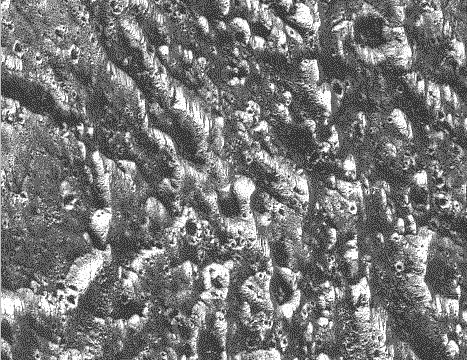Astronomy Picture of the Day
Discover the cosmos!
Each day a different image or photograph of our fascinating universe is
featured, along with a brief explanation written by a professional
astronomer.
July 12, 1996

Ancient Cratered Plains on Ganymede
Credit:
Galileo Mission
Team,
Galileo Spacecraft,
NASA
Explanation:
The largest moon in the Solar System shows regions that are ancient and
battered. The high density of craters demonstrate that patches of
Ganymede
are indeed billions of years old.
This photo is
one of a series
released by
NASA two days ago from the
Galileo spacecraft orbiting
Jupiter.
The large impact crater on the left is 19 kilometers across, while dark
indentations in
Ganymede's crusty surface-ice run diagonally.
Ganymede is composed of
half rock and half water-ice. The
Galileo
spacecraft will continue to orbit
Jupiter
over the next 16 months and send back data about
Jupiter and its
four largest moons:
Io,
Europa,
Ganymede, and
Callisto.
APOD's Archive of Galileo at Ganymede
Tomorrow's picture: M81: A Bulging Spiral Galaxy
| Archive
| Index
| Search
| Glossary
| Education
| About APOD |




Authors & editors:
Robert Nemiroff
(MTU) &
Jerry
Bonnell (USRA).
NASA Technical Rep.:
Sherri
Calvo.
Specific rights apply.
A service of:
LHEA
at
NASA/
GSFC




